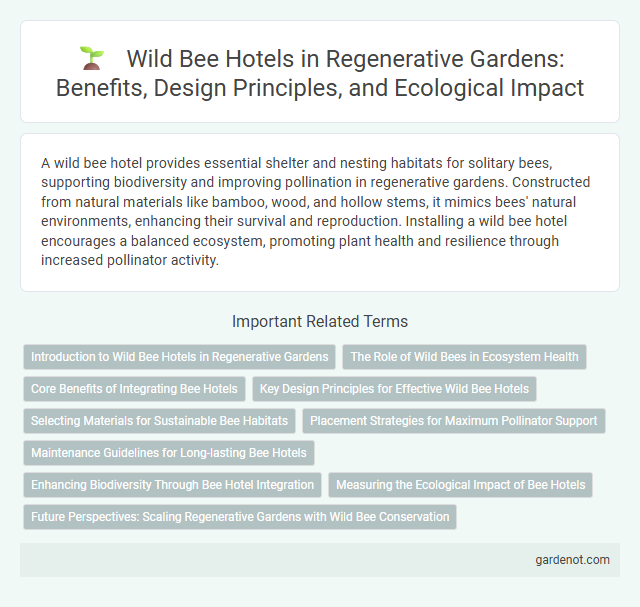A wild bee hotel provides essential shelter and nesting habitats for solitary bees, supporting biodiversity and improving pollination in regenerative gardens. Constructed from natural materials like bamboo, wood, and hollow stems, it mimics bees' natural environments, enhancing their survival and reproduction. Installing a wild bee hotel encourages a balanced ecosystem, promoting plant health and resilience through increased pollinator activity.
Introduction to Wild Bee Hotels in Regenerative Gardens
Wild bee hotels provide essential nesting habitats for solitary bees, boosting biodiversity and pollination in regenerative gardens. Constructed from natural materials like bamboo, wood, and hollow stems, these structures mimic wild nesting sites to support native bee populations. Incorporating wild bee hotels enhances ecosystem health by promoting sustainable pollinator activity within garden landscapes.
The Role of Wild Bees in Ecosystem Health
Wild bees are vital pollinators, supporting over 80% of flowering plant species and directly enhancing biodiversity in regenerative gardens. Their nesting habitats, like wild bee hotels, provide safe refuge that promotes population growth and resilience against environmental stresses. By facilitating pollination, wild bees improve crop yields and ecosystem stability, highlighting their indispensable role in maintaining healthy, regenerative landscapes.
Core Benefits of Integrating Bee Hotels
Wild bee hotels support biodiversity by providing essential nesting habitats for solitary bees, crucial pollinators in regenerative gardens. These structures enhance local ecosystems, boosting pollination rates which improve plant health and crop yields. Incorporating bee hotels fosters sustainable energy flow within the garden while promoting natural pest control and soil fertility.
Key Design Principles for Effective Wild Bee Hotels
Effective wild bee hotels prioritize materials like untreated wood, bamboo, and hollow stems to mimic natural nesting sites and ensure longevity without harmful chemicals. Proper orientation towards morning sunlight and sufficient shelter from heavy rains enhance bee activity and protection. Incorporating varied hole diameters between 2-10 mm accommodates diverse wild bee species, promoting greater biodiversity in regenerative garden ecosystems.
Selecting Materials for Sustainable Bee Habitats
Choosing untreated wood, bamboo, and natural fibers ensures a safe and eco-friendly environment for wild bee hotels, promoting sustainability in regenerative gardens. Avoiding synthetic materials reduces chemical exposure and supports the natural lifecycle of pollinators. Incorporating locally sourced materials further minimizes the carbon footprint and enhances habitat suitability for native bee species.
Placement Strategies for Maximum Pollinator Support
Positioning a wild bee hotel in a sunny, sheltered location near diverse flowering plants ensures optimal pollinator attraction and support. Elevate the hotel at least 1 meter above ground to protect from dampness and predators, while orienting the entrance toward morning sunlight encourages early bee activity. Incorporate proximity to native vegetation and avoid pesticide use within a 50-meter radius to foster a thriving pollinator habitat.
Maintenance Guidelines for Long-lasting Bee Hotels
Regularly clean bee hotels by removing debris and old nesting materials to prevent mold and parasites. Position the hotel in a sunny, sheltered spot with proper ventilation to ensure optimal conditions for wild bees. Inspect structures annually and replace damaged tubes or blocks to maintain durability and encourage continuous bee habitation.
Enhancing Biodiversity Through Bee Hotel Integration
Integrating a wild bee hotel into a regenerative garden significantly boosts local biodiversity by providing essential nesting habitats for solitary bees, which are vital pollinators. These structures support various wild bee species, enhancing pollination rates and promoting the health of native plant populations. By fostering a diverse pollinator community, bee hotels contribute to resilient ecosystems and sustainable garden productivity.
Measuring the Ecological Impact of Bee Hotels
Measuring the ecological impact of wild bee hotels involves monitoring bee species diversity, nesting success rates, and pollination activity within the garden ecosystem. Data collected from these metrics help assess improvements in local biodiversity and the restoration of pollination networks critical for regenerative gardening. Long-term studies tracking population changes and habitat preferences provide insights into the effectiveness of bee hotels as conservation tools in sustainable agriculture.
Future Perspectives: Scaling Regenerative Gardens with Wild Bee Conservation
Wild bee hotels serve as essential habitats that support pollinator diversity and enhance ecosystem resilience in regenerative gardens. Expanding the installation of these hotels promotes native wild bee populations, which are critical for sustainable crop pollination and biodiversity restoration. Scaling regenerative gardens integrated with wild bee conservation offers promising future pathways for mitigating pollinator decline and advancing climate-resilient agricultural landscapes.
Wild bee hotel Infographic

 gardenot.com
gardenot.com